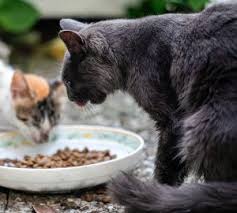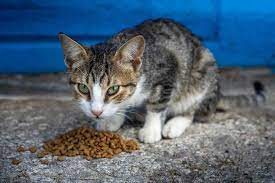It starts subtly at first. Maybe your usually sweet cat growls when you place the food bowl down. Perhaps she swats at another pet that tries to approach, or worse, snaps at your hand when you reach near her dish. Suddenly, mealtime feels tense, and you’re left asking: why is my cat suddenly food aggressive?
If you’ve noticed this unexpected behavior, you’re not alone. Food aggression in cats is more common than many owners realize, and when it appears suddenly, it can feel confusing, stressful, and even alarming. The good news? With a little understanding and the right approach, you can uncover what’s really going on and help your cat feel secure, calm, and comfortable around food again.
In this article, we’ll dive deep into the causes, misconceptions, and step-by-step solutions for sudden food aggression in cats. By the end, you’ll know exactly why your cat may be acting this way — and what you can do to restore peace at mealtime.

What Does Food Aggression in Cats Look Like?
Food aggression is when a cat becomes defensive, possessive, or hostile around food, treats, or even empty bowls. It can range from subtle behaviors to more obvious signs.
Common signs of food aggression include:
-
Growling or hissing near food
-
Swatting or biting when someone approaches the bowl
-
Guarding the dish (sitting over it or blocking others)
-
Eating too quickly, as if afraid food will disappear
-
Aggressively begging, meowing, or pawing for food
-
Attacking other pets during or after meals
When this behavior appears suddenly, it often signals a deeper issue, whether medical, environmental, or emotional.
Why Is My Cat Suddenly Food Aggressive? The Root Causes
Cats don’t randomly become food aggressive without a trigger. Understanding the root cause is the first step toward solving it.
1. Medical Problems
One of the most overlooked reasons for sudden food aggression is illness.
-
Hyperthyroidism: Causes increased hunger and restlessness.
-
Diabetes: Blood sugar fluctuations can make cats ravenous.
-
Parasites (worms): Steal nutrients, making your cat constantly hungry.
-
Dental pain: Your cat may lash out because eating feels uncomfortable.
-
Neurological issues: Can alter mood and impulse control.
👉 If aggression appeared suddenly and is severe, your first step should be a vet check.
2. Nutritional Deficiencies or Hunger
If your cat isn’t getting enough calories or nutrients, food aggression can surface quickly.
-
Recent diet change? A lower-quality food or smaller portions could trigger hunger-driven aggression.
-
Kitten to adult transition: Some cats struggle with portion reductions as they grow.
-
Multiple pets: Another cat or dog may be sneaking food, leaving yours hungry.
3. Stress, Anxiety, or Environmental Changes
Cats thrive on routine. Stress can make them hyper-focused on food as a source of comfort or control.
-
New pet, baby, or visitor in the home
-
Moving houses or rearranging furniture
-
Sudden change in feeding schedule
-
Competition at mealtime (other pets in the house)
4. Past Trauma or Learned Behavior
If you adopted your cat, especially from a shelter or the streets, food aggression may come from survival instincts. Cats who experienced scarcity often develop “resource guarding” behaviors — even years later.
5. Age-Related or Cognitive Changes
Senior cats may experience cognitive dysfunction (similar to dementia in humans). Confusion, disorientation, and altered behavior can make them suddenly protective of food.
Why You Shouldn’t Punish Food Aggression
A common mistake owners make is scolding, spraying, or physically removing a cat when aggression happens. Unfortunately, this backfires.
Punishment makes cats:
-
More fearful and defensive
-
More likely to escalate aggression
-
Distrustful of you at mealtime
Instead of punishment, focus on understanding, prevention, and positive reinforcement.

How to Stop Sudden Food Aggression in Cats
Once you know the possible causes, you can work on practical solutions.
Step 1: Rule Out Medical Issues
Book a vet visit to check for hyperthyroidism, diabetes, parasites, or dental pain. Medical causes must be treated before behavioral solutions will work.
Step 2: Adjust Feeding Routines
-
Multiple small meals: Feeding smaller, more frequent portions helps cats feel secure.
-
Timed feeders: Automatic feeders reduce tension between cats and create consistency.
-
Separate feeding stations: If you have multiple pets, feed them in different rooms to eliminate competition.
Step 3: Reduce Stress in the Environment
-
Keep feeding areas quiet and safe.
-
Maintain a predictable routine.
-
Use calming aids like pheromone diffusers (Feliway).
-
Provide enrichment (scratching posts, playtime, climbing spots) to reduce anxiety-driven aggression.
Step 4: Build Positive Associations
-
Reward calm behavior around food with gentle praise.
-
Never take food away mid-meal.
-
Slowly desensitize your cat by sitting near during meals without interfering.
Step 5: Provide Adequate Nutrition
-
Check your cat’s food quality — is it high in protein and appropriate for their life stage?
-
Ask your vet about portion sizes.
-
Consider supplements if deficiencies are suspected.
Real-Life Example: Milo’s Story
Milo, a 6-year-old rescue, suddenly began growling at his owner during dinner time. A vet check revealed early hyperthyroidism, which was causing intense hunger. Once treated with medication and provided with smaller, frequent meals, Milo’s aggression faded, and mealtime peace returned.
Common Mistakes to Avoid
-
Free-feeding multiple cats: Leads to competition and stress.
-
Suddenly changing food brands: Can cause both digestive upset and behavioral issues.
-
Ignoring aggression: Hoping it will stop often makes it worse.
-
Feeding once a day: Long gaps can trigger resource-guarding instincts.
Industry Insights: What Experts Say
Veterinary behaviorists increasingly recognize food aggression as a mix of instinct and environment. Studies show cats with early-life scarcity are more likely to develop lifelong guarding behaviors. Meanwhile, advances in feline nutrition highlight that high-protein, species-appropriate diets can significantly reduce food-related aggression.
FAQs About Food Aggression in Cats
1. Why is my cat suddenly attacking me when I feed her?
This could be due to pain, extreme hunger, or anxiety. Always check for medical issues first.
2. My cat growls while eating but doesn’t attack. Should I be worried?
Growling alone isn’t dangerous, but it’s a sign your cat feels insecure. Try separating feeding areas and offering more frequent meals.
3. Can food aggression go away on its own?
Rarely. Without addressing the cause, it often escalates.
4. Do kittens show food aggression too?
Yes, especially in large litters or if they were strays. Most grow out of it with consistent feeding, but some carry it into adulthood.
5. Will neutering or spaying stop food aggression?
It can reduce some territorial or competitive behaviors, but food aggression usually requires direct intervention.
6. Can cats become food aggressive due to other pets?
Absolutely. Dogs, other cats, or even humans hovering nearby can make a cat defensive.
Final Thoughts: Helping Your Cat Feel Secure Around Food
If you’ve been asking yourself, “why is my cat suddenly food aggressive?”, remember that aggression is your cat’s way of communicating distress. Whether the trigger is medical, emotional, or environmental, your cat isn’t being “bad” — she’s trying to cope.
With a combination of veterinary care, smart feeding strategies, stress reduction, and patience, most cats can overcome sudden food aggression. By understanding the root cause and responding with empathy, you’ll not only restore peace at mealtime but also strengthen the bond you share with your cat.
